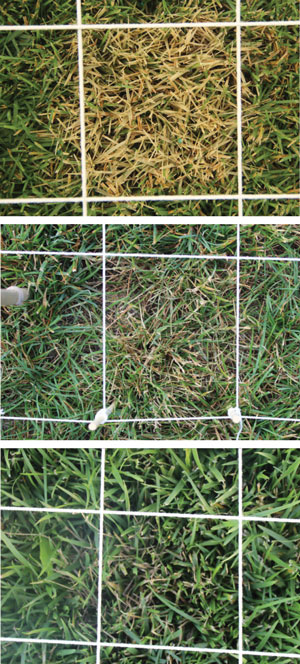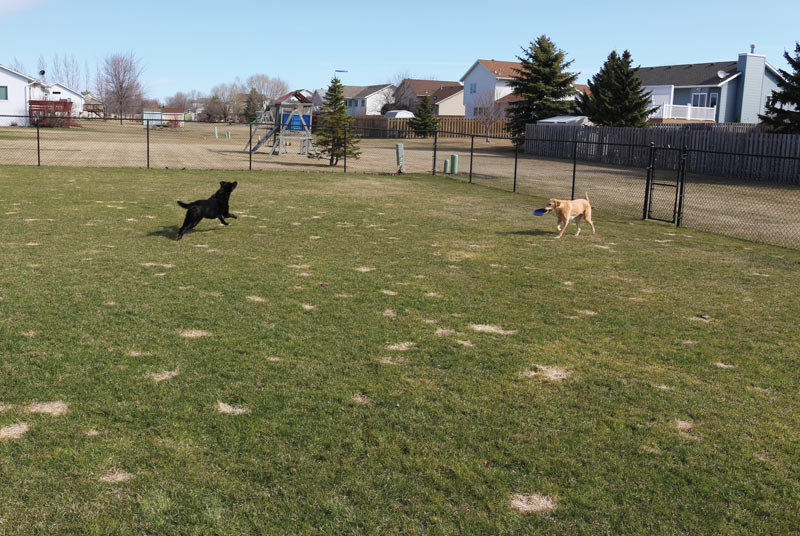
Dog urine tolerance among turfgrass species and cultivars
Dog urine damage on turfgrass has recently been shown to be caused mainly by lactic acid rather than soluble salts in dog urine. The objective of this field study was to compare two cultivars of seven commonly used turf species (bermudagrass, creeping bentgrass, Kentucky bluegrass, perennial ryegrass, strong creeping red fescue, tall fescue and zoysiagrass) to determine their relative tolerance to dog urine.
Lactic acid at 35 grams/liter of water was used as a substitute for dog urine in the screening. We also treated 29 Kentucky bluegrass cultivars, nine perennial ryegrass cultivars and 26 tall fescue cultivars with lactic acid and compared their relative tolerance.
In general, bermudagrass and zoysiagrass were more tolerant to lactic acid than the cool-season grasses were. Tall fescue, creeping red fescue, perennial ryegrass, Kentucky bluegrass and creeping bentgrass tolerated lactic acid in descending order.
However, lactic acid tolerance varies widely within species. Each species had cultivars ranked as tolerant to dog urine, with <15% green color density decrease and <80% phytotoxicity (slight discoloration or stunting). These cultivars were: Arid 3, Ruby, Green Label, Jaguar 3, Aries and Justice tall fescue; Accent II and Fairway perennial ryegrass; and Super Glade and Nu Destiny Kentucky bluegrass.
Using tolerant turfgrass species or cultivars to minimize dog urine damage may be a practical option.
— Deying Li, Ph.D., North Dakota State University, Fargo, N.D.; Zhihui Chang, Cheng Wang and Gang Wang, Turfgrass Research Institute, Beijing Forestry University, Beijing
Can water repellents protect turf from dog urine damage?

A preliminary experiment showed that the mode of action of dog urine damage on turfgrass is similar to that of glyphosate herbicide. We hypothesized that the physical structure of the turfgrass, such as leaf blade width, leaf hair and surface wax, contributes to the tolerance. We also expected that applying waxy substances to grasses may prevent penetration of dog urine into the leaves. Our objective was to evaluate whether different water repellents protect cool-season turfgrass species from dog urine damage.
Momentum creeping red fescue, Abbey Kentucky bluegrass, Majesty II perennial ryegrass and Faith tall fescue were selected for the study because of their sensitivity to dog urine. On Nov. 15, 2019, these cultivars were seeded to plastic pots and maintained at 1.9 inches in the greenhouse. On March 13, 2020, each cultivar received an application (425 milliliters/square meter) of the water repellents TransFilm, Rain-X, Moisture-Loc, Wilt Stop, Wilt-Pruf and Encase Anti-Transpirant.
At one week and two weeks after the treatments, artificial dog urine (35 grams/liter lactic acid, 20 grams/liter urea, 10 grams/liter ammonia sulfate), coyote urine and a control (water) were sprayed on the treated cultivars. One week after the first treatment, creeping red fescue, Kentucky bluegrass and perennial ryegrass were injured by all urines. Tall fescue was not injured by coyote urine. The water repellents did not protect against urine damage in tall fescue and perennial ryegrass. In Kentucky bluegrass, the only difference was between Wilt-Pruf and Encase Anti-Transpirant, but neither differed from the untreated control. Protective differences in water repellents were seen only in creeping red fescue, which is more tolerant than other species (previous study; data not reported).
Similar results were seen one week after the second urine treatment. After the second treatment, use of TransFilm resulted in better visual turf quality in creeping red fescue, although results with Rain-X were similar. The results confirmed those from the previous week. The recommended rate of TransFilm protected the turf up to two weeks after application.
— Matt Becker and Deying Li, Ph.D., North Dakota State University, Fargo, N.D.
Photos by Deying Li
Editor’s note: Earlier versions of these summaries were published in the 2019 and 2020 ASA-CSSA-SSSA Meeting Abstracts, ASA-CSSA-SSSA, Madison, Wis.
Teresa Carson is GCM’s science editor.